Unpretentious large-fruited honeysuckle variety “Bakcharsky Giant”
Bakchar giant is a large-fruited honeysuckle variety that has many positive characteristics. Among them, first of all, they note a high degree of frost resistance, strong immunity and unpretentiousness. We offer to learn in detail about the best time to plant plants, how to choose the right planting site and prepare the site, and how to care for the bushes to get a rich harvest.
Description of the honeysuckle variety Bakcharsky giant
Bakchar giant - a large-fruited variety of edible honeysuckle of domestic selection, 100 g of berries of which contain 8.4% sugar, 2.0% acid and 37 mg of vitamin C.
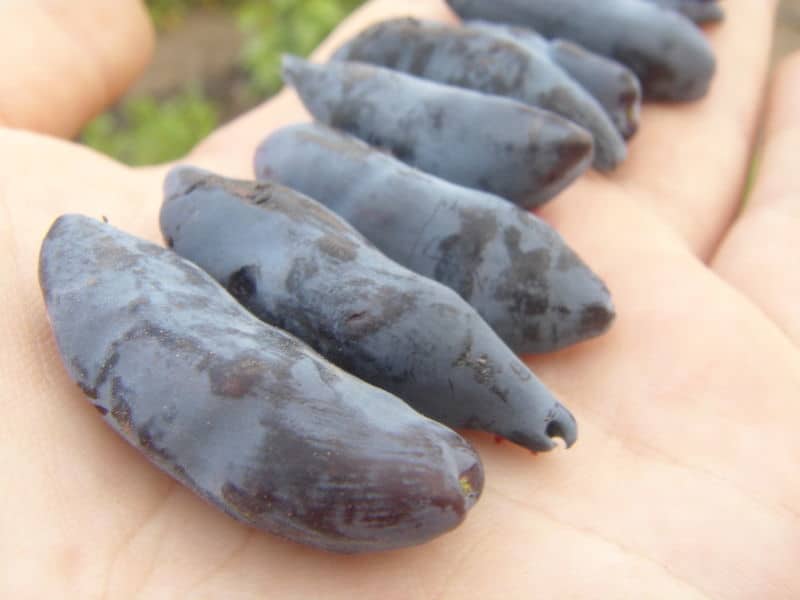
Origin and development, history of breeding
Honeysuckle Bakcharsky giant was bred by breeders of the Federal State Unitary Enterprise "Bakcharskoye" (Tomsk region) I.K. Gidzyuk, N.V. Savinkova and A.P. Pavlovskaya.
The variety was included in the State Register of Russia in 2005.
Characteristics, description of appearance, taste
The bushes of this variety of honeysuckle are vigorous (reach a height of 2 m), spreading, with a rounded but slightly pointed crown, thick, erect, hairless shoots of a brown-brown color.
The leaves are large, dark green. The leaf blades are medium pubescent, not dense, the surface is matte, the flowers are medium sized.
The berries are elongated-oval in shape, covered with a blue-blue skin of medium thickness, reach a length of 5 cm and weigh on average 1.8 g.
The pulp is juicy, has a gentle sourishsweet taste.
Features of the use of this variety
The fruits of the Bakchar giant are characterized by the possibility of universal use: they are consumed fresh, frozen, used for making juices, compotes, preserves, liqueurs and wine.
Ripening period, yield and fruiting
This is a medium-ripening honeysuckle - the first berries ripen in early June. Fruiting begins 3-4 years after planting.
On average, 1.8-3 kg of berries are harvested from a bush, and under favorable conditions - up to 4.5 kg.
Reference. Average productivity for industrial cultivation - 53 c/ha.
Resistance to diseases and pests
The variety is characterized by stable immunity, but in rare cases it can still be affected by powdery mildew, tuberculosis, aphids, roseate leaf rollers, and honeysuckle.
Resistance to cold and drought
This is a frost-resistant variety of honeysuckle - the bushes can withstand air temperatures dropping in winter to -35°C and up to -10°C in the event of return spring frosts during flowering.
Plants cannot tolerate excessive soil moisture - it leads to the development of diseases and rotting of the root system. At the same time, the lack of moisture contributes to the appearance of bitterness in the taste of the berries.
For which regions is it best suited and what are the climate requirements?
The purpose of breeding the Bakchar giant was to obtain honeysuckle suitable for growing in cold climates. The variety is recommended for planting in Siberia and the Central European part of Russia.
The variety is included in the State Register of Russia with permission for cultivation in the Northern, Northwestern, Central, Volga-Vyatka, Central Black Earth, North Caucasus, Middle and Lower Volga, Ural, Far Eastern, Western and Eastern Siberian regions.
The main advantages and disadvantages of the variety
The main advantages of the variety include:
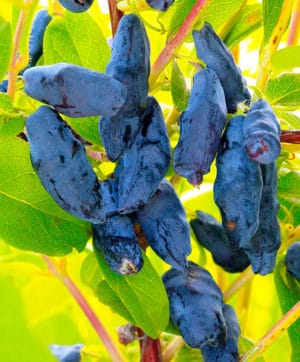
- large-fruited;
- high degree of frost resistance;
- pleasant taste of berries;
- stable fruiting;
- easy harvesting;
- resistance to diseases and pests;
- transportability.
Among the disadvantages of the Bakchar giant are low yields and a tendency to shed ripe berries.
What is the difference from other varieties and hybrids
Comparison of the Bakchar giant with other varieties of medium-sized honeysuckle ripening period:
| Variety | Average weight of berries, g | Taste | Berry color | Productivity, kg/bush |
| Bakchar giant | 1,8 | Sweet and sour | Blue | 1,8-3 |
| Amphora | 1,3-3 | Sweet and sour with bitterness | Dark blue | Up to 2 |
| Cinderella | 0,5-1,3 | Sweet and sour with strawberry aroma | Dark blue, almost black | 5,5 |
| Malvina | Up to 1.1 | Sweet and sour | Bluish blue | 1,6-3,2 |
Agricultural technology
This is an unpretentious variety of honeysuckle, but for the survival of seedlings, good plant development and a rich harvest, it is necessary to follow the rules for planting and caring for bushes.
Choosing a place in the garden and preparing holes
Bakchar giant bushes are planted in a well-lit, elevated place near fences that will protect the plants from gusty winds. The permissible depth of groundwater is no higher than 1.5 m, the optimal option is 2-2.5 m.
Reference. Despite the need for good lighting, the lower branches of the bushes should be shaded.
Preparing for landing
When buying planting material, the choice is made on seedlings with a healthy root system, flexible shoots and 4-5 leaves. Before planting, plant roots are soaked for half an hour in a solution of a growth stimulator (Heteroauxin, Kornevin).
The area is cleared of weeds, debris and plant debris in advance, humus, rotted manure, peat or compost (10 kg per 10 sq. m. area) are scattered over the soil surface and dug up.
Soil requirements
Honeysuckle grows well in loose, light and fertile soil with a neutral acidity level, good moisture and air permeability. The most suitable option is loam. In soil with high acidity, additional lime or dolomite flour is added.
Dates, scheme and rules of planting
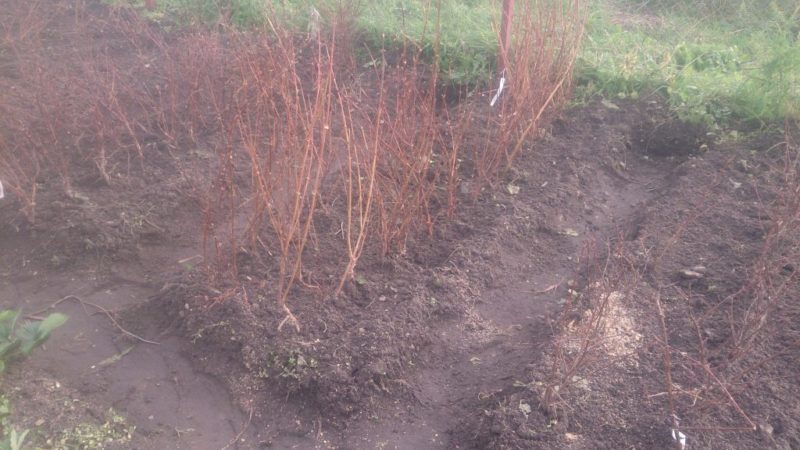
Bushes of the Bakchar giant are planted in a permanent place in September-October, so that during the winter they have time to take root and get stronger.
Planting pattern:
- In the prepared area, dig planting holes measuring 40 x 40 cm.
- Place a drainage layer of expanded clay or broken brick at the bottom of each hole, fill the holes with a nutritious soil mixture (the top layer of excavated soil, 50 g of potassium salt and superphosphate).
- Form a hill from the soil mixture the size of the plant's root system.
- Place a seedling in the center of the hill and spread its roots along the slopes.
- Fill the voids with soil so that the growing point is recessed by a maximum of 3 cm.
- Compact the soil and water the plantings at the rate of 5 liters of water for each bush.
Reference. The distance between bushes should be 1.5-2 m.
Features of cultivation and nuances of care
When watering the Bakchar giant, they are guided by the weather and climatic conditions of the growing region. On average, bushes are watered every 3-7 days, water consumption is 8-10 liters for each plant. The soil should be moistened to a depth of 40 cm.
After each watering, the soil is loosened. This helps improve the access of moisture and oxygen to plant roots and avoid the formation of a dry crust on the soil surface.
Fertilizers are applied according to the following scheme:
- spring - nitrogen-containing fertilizers that promote the growth of green mass (for example, 15 g of ammonium nitrate per bush);
- after fruiting - nitrophoska (25 g per 5 liters of water) or potassium-phosphorus fertilizers;
- autumn - organic fertilizing (1 part manure to 10 parts water), consumption of 10 liters per bush.
Pruning begins 3 years after planting honeysuckle. In the spring, all dry, broken, damaged and tilted shoots are cut off from the plants so that 10-15 branches remain on the bush. For old bushes, anti-aging pruning is carried out - all branches are cut at a level of 30-35 cm.
Pollinators
The flowers of the Bakchar giant do not pollinate on their own - this variety of honeysuckle requires cross pollination. pollination. To obtain a harvest, additional pollinating varieties are planted on the site - In Memory of Gidzyuk, Lazurnaya, Amphora, Pride of Bakchar, Nymph.
Disease and pest control
Diseases and pests that can affect the bushes of the Bakchar giant:
| Disease/pest | How to get rid |
| Powdery mildew | Treatment of bushes with fungicidal preparations, a safe and effective remedy - “Allirin B” |
| Tuberculariosis | |
| Aphid | Treatment before flowering with “Green Soap” (400 ml per 10 liters of water) |
| Rose leaf roller | Spraying with Arrivo insecticide |
| Honeysuckle fingerwing | Spraying with Agravertine |
| To prevent the development of diseases and pest attacks in early spring, before the flowering period, the bushes are sprayed with Bordeaux mixture | |
Preparing for winter
The Bakchar giant is a frost-resistant variety of honeysuckle; its bushes do not require additional shelter for the winter or special preparation for frost.
Reproduction
There are several ways to propagate this variety of honeysuckle:
- By layering. In summer, the soil around the bush is dug up so as not to touch the root system. The lower branches are tilted to the ground, secured with special brackets and sprinkled with soil. After a year, the rooted branches are separated from the mother plant and planted in a permanent place.
- Cuttings. At the end of May, a part 10-15 cm long with 3 buds is cut off from a young shoot, moistened in a solution of a growth stimulator (Epin, Kornevin), placed in a container with soil and covered with a jar or plastic bottle to create a greenhouse effect.
- Bones. The seeds are collected from overripe fruits, sown in containers with substrate and sprinkled with snow. When warm days arrive, the containers are covered with polyethylene until shoots emerge.
Harvesting
The harvest is harvested when the berries acquire a uniform dark blue color. They spread a cloth or film under the bush and shake the plant so that the fruits fall off. For transportation, the berries are placed in a single layer in a shallow container. When fresh, the harvest can be stored in the refrigerator for no longer than a week.
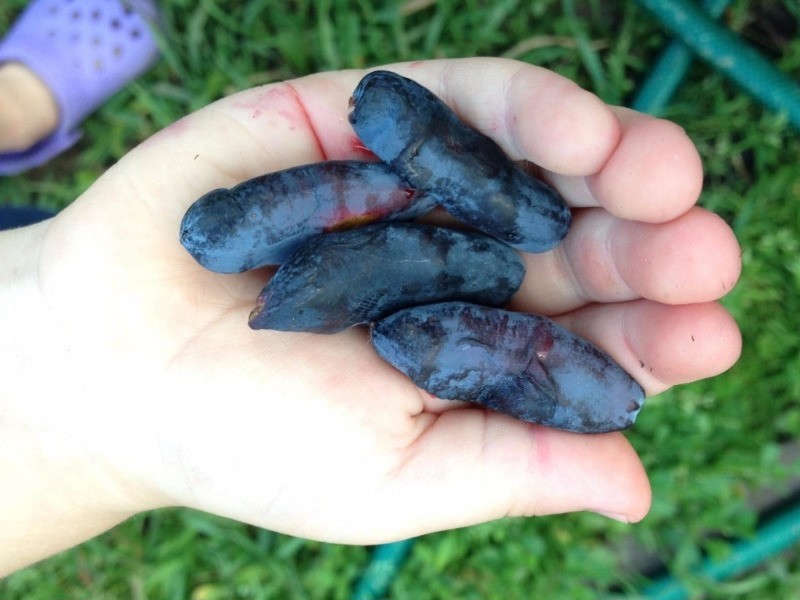
What difficulties may there be when growing
When growing the Bakchar giant, the following difficulties may arise:
- rotting of the root system, powdery mildew - the consequences of swampy soil due to excessive watering or planting bushes in lowlands;
- the appearance of bitterness in the taste of the berries is the result of growing honeysuckle in the shade.
Tips and reviews from experienced gardeners about the variety
Experienced gardeners recommend:
- choose a place for planting bushes so that they are protected from the wind by buildings or other plants, otherwise the yield of honeysuckle will be reduced;
- do not neglect preventive treatments and spray the plantings with Bordeaux mixture in early spring - despite the good immunity of the variety, it can still be attacked by diseases and pests.
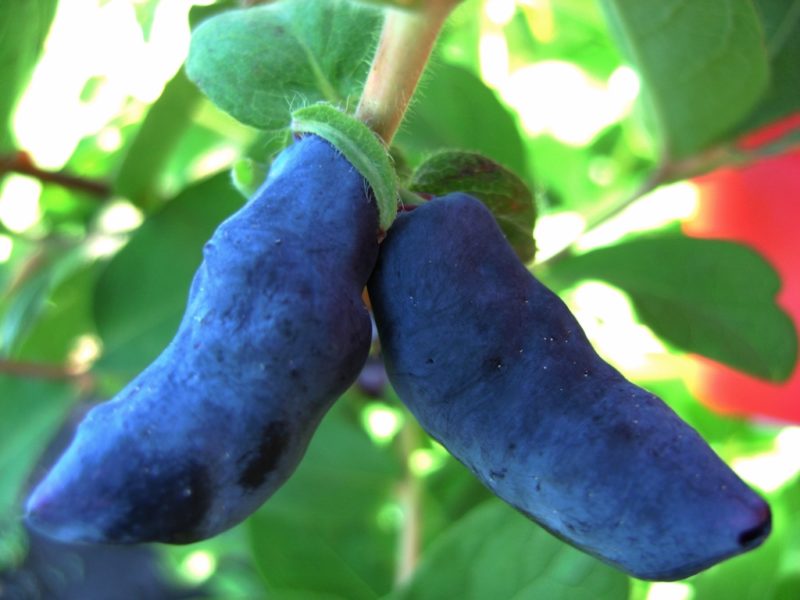
They respond positively to the variety:
Veronica, Omsk: “I like this variety of honeysuckle - the berries are very tasty, the bushes are easy to care for, and the harvest is easy to harvest. The only drawback that I can note is the low yield.”
Evgeniy, Izhevsk: “This variety was recommended to me by my neighbors. I bought several seedlings and immediately took Azure and Amphora for pollination. Overall, I was pleased with the result - with minimal care, several years after planting, I collected a little more than 2 kg of berries from the bush. The fruits are large, tasty, sweet with a slight sourness.”
Conclusion
The Bakchar giant is the result of the work of domestic breeders, whose goal was to obtain a honeysuckle variety suitable for cultivation in the northern regions. This variety is characterized by high resistance to frost, large fruit, good immunity and a pleasant taste of berries. Among the disadvantages, gardeners note only the need for planting pollinator varieties nearby and low yields.